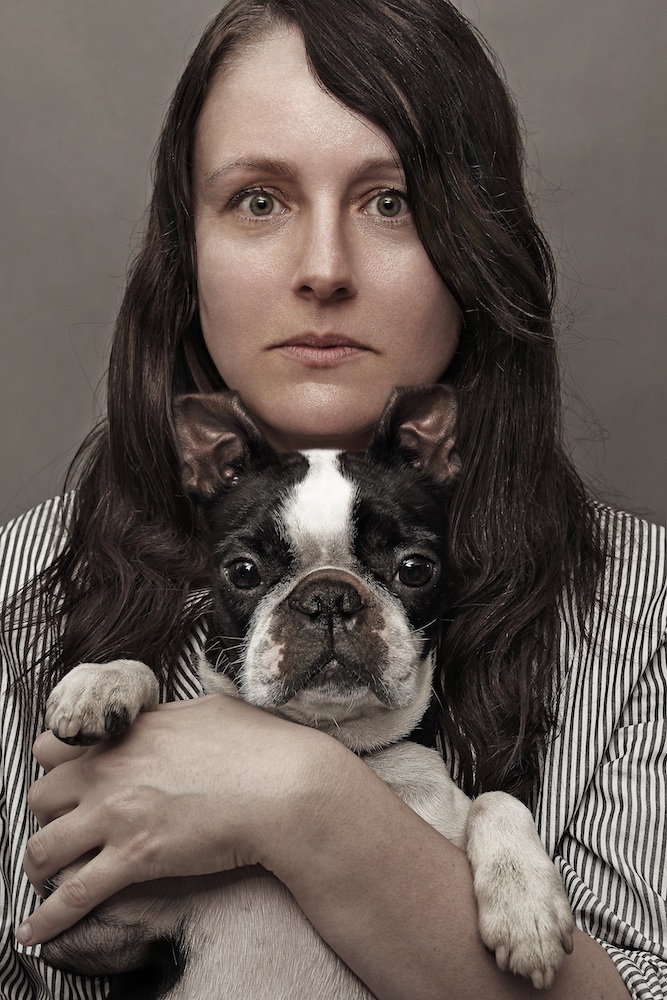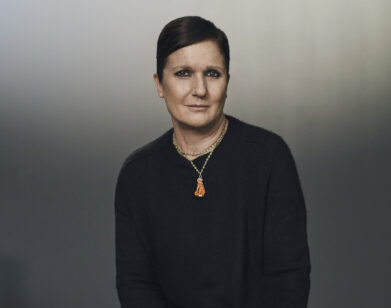Ann-Sofie Back to the Future
“Where I grew up, fashion was considered superficial,” explains Swedish-born designer Ann-Sofie Back. “It should be practical instead,” she continues. “I have that ingrained in me, which is why I don’t take it so seriously”.
Fittingly, when we meet Back in London, she is sporting a black ensemble paired with sheer ankle socks and sneakers. Back first appeared on the fashion scene working for British designer Joe Casely-Hayford, Swedish label Acne Jeans, and designing capsule collections for Topshop. Now, the designer has an eponymous label, BACK by Ann-Sofie Back, and is also the creative director for the denim brand Cheap Monday. Her client list impressive; among the more fashion-forward celebrities who favor Back are Noomi Rapace, Rihanna, Lady Gaga and Chloë Sevigny.
We spoke with the charmingly deadpan designer about punk, the future of fashion, and why she prefers dogs to cats.
KATE LAWSON: Was there a lightbulb moment when you knew fashion design was what you wanted to do?
ANN-SOFIE BACK: It was actually my parents’ total lack of interest for fashion, art, and anything beautiful at all that moved me towards it. My way of rebelling when I was younger was to find my own niche and, later on, my mother helped me to find out about how to become a fashion designer. It sounded so complicated though—having to know about PR, drawing, and everything else. I thought, “I’ll just be a lawyer instead.” [laughs] When I was 18, I applied for an Art Foundation course and then it all started from there.
LAWSON: Did you express that rebellious side in the clothes you wore back then?
BACK: Not all the time, but I remember a girl in my class who was a punk rocker and I thought she was the most amazing person I had ever seen—her spiky hair and the pins in her clothes and trash trousers. I copied that style, quite badly though. [laughs]
LAWSON: So you were into DIY?
BACK: Yes. I took old leggings and cut them off and attached pins to them, but I didn’t really know what to expect or the reaction from people. My mum was like, “Oh you look nice, where are you off to?” [laughs] Later as a teenager I was really trendy and into everything I could get my hands on. There was a Gaultier shop that I went to every weekend. I would just stand outside the window, look in and sigh.
LAWSON: Well you’re similar to Gaultier in that you’ve become synonymous for translating your rebellious side through design—what was the reaction to that when you were first starting out?
BACK: When I graduated from Central Saint Martins, it was around the same time that Viktor & Rolf were starting out and the scene was very different—there was more room for doing your own thing. I sold my first collection straight away and also had a lot of Japanese stockists. I think it was more experimental back then; now it seems the industry has become more conservative.
LAWSON: You’re certainly not conservative. With such an experimental attitude towards womenswear, would you describe yourself as a feminist?
BACK: Yes, absolutely. I don’t know how anyone couldn’t be a feminist; it’s totally bizarre not to be. That goes for men too.
LAWSON: So what’s your opinion on the new wave of female role models who are supposedly “empowering” women, like Miley and Rihanna?
BACK: Personally, I love Rihanna because I think she does what she does for herself, but with Miley it feels like she doesn’t really understand what she’s doing or trying to say.
LAWSON: If you could dress one female powerhouse in your designs, who would you choose?
BACK: I don’t really think too much about things like that, but I like Rihanna’s attitude and I also really like Robyn, because she promotes other female artists and has her own record label. There have also been Swedish female rap artists like Linda Pira wearing our designs in her music videos, but I didn’t seek out that connection, it just happened. I thought that was really cool.
LAWSON: Aside from music, you also have a connection with art, as your designs have been exhibited at the ICA, the V&A, and the Palais du Tokyo in Paris. Is art important to you?
BACK: I see my work as an art form, but I find fashion so much more intriguing and fascinating than art could ever be. In hindsight, those associations for me were not great because I was labeled as “weird” or “arty and not really fashion.” I suppose I didn’t help those pre-conceived ideas about my designs with shows like “Back to Front” [in which models came out for the finale first] I think at that time I had this complex where I needed fashion to be something more than just clothes; I had to have an excuse for myself, but now I don’t feel that I need that anymore.
LAWSON: So where do you draw your outside influences from when you put a collection together?
BACK: For example, the starting point for this BACK F/W 2014 collection was me being super fed-up with how the collections these days have to be so planned—you have to have one cardigan at that price and one sweater at that price. So I wanted it to have a raw, naïve, and spontaneous feel to it, which is where all the knotting and twisting detail comes in. Other outside influences come from previous collections where I’ve wanted to explore them more so I re-work them again, like the bra-cup detailing in the F/W 2014 pieces, they were in my first ready-to-wear collection in 2002.
LAWSON: What about that fusion of Swedish and British influences? Having studied at both Beckmans in Stockholm and CSM, how do you think student fashion has evolved?
BACK: In Sweden, they have started to be more theoretical and demand more research from students. When I was studying there, research didn’t exist, you just sat at a table and started to draw. When I came to CSM, I saw people going to the library and reading books and so I had to adapt to that. But when I look at the BA Show at CSM now in comparison with Beckmans, I don’t think it’s more creative in London anymore. I think things are changing. Sweden is definitely catching up.
LAWSON: Speaking of change, the digital revolution in fashion has had such a huge impact on brands and designers—what’s your take on the future of fashion?
BACK: I read an article recently that said how the avant-garde is the new mainstream and that within the e-business, it seems you can sell slightly weirder fashion online than in the shops. I find that really interesting for the future of fashion, because the end-customer exists more than you really know.
LAWSON: So when you’re not thinking about your customers, how do you relax outside of the fashion circus?
BACK: I have a Boston terrier, and getting a dog completely changed my life. I really love spending time with her and with other dog owners. I used to think I was a cat person, but I’m definitely a dog person now. Cats are completely useless, they’re just like difficult plants, there’s nothing there. [laughs]
FOR MORE INFO ON ANN-SOFIE BACK, VISIT HER WEBSITE







